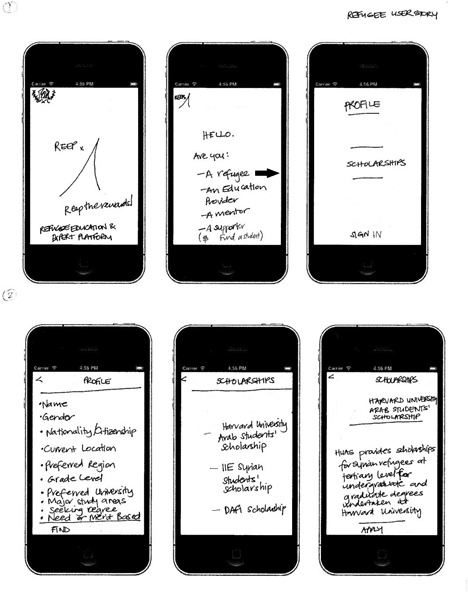Access to higher education scholarships, training, and professional opportunities for refugees is essential. Yet, just one percent of refugees attend university compared to 34 percent of people globally.[1] Of the more than 4 million Syrian refugees in the world today, the International Institute for Education (IIE) estimates at least 100,000 university-qualified students are not in higher education.[2] At the onset of the conflict, 26% of Syrian young people were enrolled in tertiary education.[3] Today, Syria’s higher education system is all but decimated, leaving behind hundreds of thousands of young Syrians, and with them, the scholars and leaders of tomorrow, many of whom will play a significant role in rebuilding Syria and its institutions.
Education is often interrupted when people are forcibly displaced across borders. Unfortunately, the cost of education remains the most prohibitive factor preventing refugees from re-entering higher education. In recognition of this fact, there has been a recent proliferation of tertiary scholarships for refugees, particularly for Syrian refugees. However, whilst demand for these opportunities still outstrips supply, few Syrian refugees are aware of the scholarship opportunities that are available to them; much less how to take advantage of them. A recent spike in the number of scholarships, vocational training opportunities, and labour mobility initiatives highlights the need for a comprehensive UNHCR-supported platform that consolidates these opportunities so that refugees are better able to harness them.
- Due to capacity constraints, however, UNHCR does not at present provide services to match refugees with tertiary scholarships that best suit their preferences. While there are various websites that identify some available scholarships, currently there is no one-stop comprehensive and searchable platform for refugee scholarships available.
That’s why, in June 2015, I set about designing the Refugee Education and Expert Platform (REEPx); a global scholarship-finder platform that would also provide access to professional mentoring, vocational training and labour mobility opportunities. The web-integrated smartphone app would help refugees easily find tertiary scholarships tailored to their needs and preferences. Offering a dedicated space for education providers and universities to advertise their scholarships for refugees, it would also assist UNHCR to vet those scholarships, facilitate direct contact between refugees and mentors, and enable donations at the click of a button to fund refugees’ tertiary studies, through the platform.
Version 1 of REEPx was designed to be available in Arabic and English, filling the obvious gap by connecting Syrian refugees with tertiary scholarship opportunities. Subsequent versions were designed to cater to other major refugee populations through additional language versions and culturally relevant user experiences and additional functionalities including access to mentors. In this way, REEPx was also designed to be scaled to other refugee populations and for broader education and employment purposes.
After 18 months of research and development, I was able to attract significant interest in the platform from the private sector and internal stakeholders, and in 2016 I completed a UNHCR Innovation Fellowship. However, a similar concept developed by an NGO for the MENA region, and the announcement by the IIE in November 2016 of a similarly named initiative to develop a near-identical concept to REEPx,[4] presented major challenges to the development plans for REEPx, placing a question mark over whether it will eventually go live. Below, I share some of the valuable lessons I’ve learnt throughout the innovation process to date.
5 key tips to keep in mind
- Do your homework.
Ask yourself a lot of questions (and keep asking yourself these throughout the process): Am I reinventing the wheel? What is the purpose of what I am creating? Is the thing I am creating going to serve that purpose? If you answer the first of these questions in the affirmative, you should ask yourself why you are investing – and why anyone else would invest to develop (or further develop) your innovation. The second, third and fourth questions are to ensure relevance, effectiveness, and impact of your innovation. Is your idea going to serve the need you set out to address in the first place? If it isn’t, you should again ask yourself why you are investing in the further development of your innovation – and why you are asking anyone else to do so. If your innovation speaks directly to one or more key strategic areas of focus of the organization, including organizational strategies and policies, this is a good first sign (and will be key to establishing institutional ‘buy-in’ down the track). But remember to continually come back to these questions throughout the process, and refine your innovation (‘iterate’ it) accordingly. One of the best ways to do this is to write it down. Draw your innovation and keep drawing it every few weeks or whenever you have a new idea about it. It will evolve, and this is a good thing. Storyboards that assist you to see how each piece of the puzzle fits together are very useful, including for explaining your innovation to others and ensuring you have thought through and joined all ‘links in the chain’, as these early ‘user story’ drawings illustrate:

- Mentorship and buy-in are key.
Identify an in-house mentor/champion who will help drive and ‘market’ your innovation internally and externally. This is essential and should form part of your early stakeholder mapping exercise. An in-house champion will also help you to discern the best entities to partner with and in theory, should assist you to gain their necessary ‘buy-in’. Choose your champion wisely; think not only about their own areas of focus but also about their strategic potential to help you drive your innovation forward. What are they passionate about? What are they focusing on? Ideally, they will play a key role in advocating for your innovation and linking it to other organizational strategic events and priorities, thus helping you to ‘insert’ your innovation where relevant. Don’t be afraid to reach out to senior management in the organization about your innovation.
- Find mutually reinforcing strategic initiatives and engage your end-users.
Formally engage in strategic initiatives that will provide you with a ‘testing’ ground for your innovation, or which will provide a ‘launching pad’ for your concept. For example, as I was developing a scholarship and mentoring platform for refugee youth, it made sense to attend the Global Refugee Youth Consultations where I could seek initial user-feedback on my low-fidelity prototypes from refugee youth themselves who had direct experience with applying for education scholarships (and who ultimately put me in touch with some of my best ‘partners’). Had I been able to formally present the platform to refugee youth at the GRYC, however, this would no doubt have leant significant credibility to the platform as a concept and may well have further driven its development. While access to these events may be difficult in some cases, refer back to tip #2 and explore whether your in-house champion may be of assistance.
- Seek multiple perspectives on your innovation.
Talk to as many people as possible about your innovation, and seek as many perspectives on your idea as you can, within and outside of your organization. Think of every person you speak to about your idea as a stakeholder and sincerely seek their feedback. Be humble and listen. This will help you to gain different perspectives on your innovation and to see it from new angles. This is crucial to ensure you haven’t overlooked any step in the process; they may provide your innovation with an added detail you didn’t previously realize it needed, and it will be extremely valuable in helping you to create your ‘user stories’. It will also help you to tailor the way you ‘sell’ your innovation to different end users or attract investors (on this note, you should not be afraid to ‘tailor the sell’ of your innovation differently, depending on your audience – in fact, you should do this). Just remember this: some won’t be as convinced as you are about your own idea, but you don’t need to take all the advice you receive on board. Not every piece of advice you receive is good advice and just because you seek it, doesn’t mean it must be incorporated into your design process.
- Your idea is just an idea until it isn’t.
In the beginning, when I was conceptualizing REEPx, I was afraid that if I told too many people about it, or elaborated too many of its details, someone would steal my idea. Then a wise friend, who was in the process of developing an app himself, reminded me that until you have your prototype down on paper and moving as a project, it’s just an idea… You might be the first one to have the idea, but many people often come up with the same idea at around the same time. Talking about your idea can be risky, but it’s one you need to take if you want to get your project moving and ultimately, to create exposure. Competitors may end up REEPing the benefits of your idea, but what matters is whether, in the end, the end user has a good solution to their problem. In this case, whether the refugee is better equipped to find the right scholarship in order to continue their education.
[1] Global enrolment rates refer to 2014 (UNESCO Institute for Statistics) and refugee enrolments rates refer to 2015 (UNHCR). See, UN High Commissioner for Refugees (UNHCR), Missing Out: Refugee Education in Crisis, September 2016, available at: http://www.refworld.org/docid/57da83714.html
[2] James King, ‘The “Delivering Higher Education to Syrian Refugees” Workshop: A Rare Moment of Guarded Optimism’, The IIE Blog, Wednesday, January 6, 2016, available at: http://www.iie.org/Blog/2016/January/The-Delivering-Higher-Education-To-Syrian-Refugees-Workshop#.WFwoiuErJE4
[3] UNESCO Institute for Statistics, Syrian Arab Republic Education and Literacy, available at: http://uis.unesco.org/country/sy
[4] Institute for International Education, Press Release, 7 November 2016, “IIE Offers Scholarships for Syrian Students with Support from Major Foundations”, available at: http://www.iie.org/Who-We-Are/News-and-Events/Press-Center/Press-Releases/2016/2016-11-07-IIE-Offers-Scholarships-for-Syrian-Students#.WFzfwOErJE5

